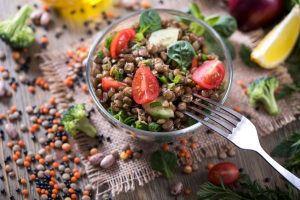
To some, “clean eating” it means eating nothing but raw foods. To others, it means eating only organic. This phrase is bantered around in the health and fitness industry. Its definition varies between authorities and professionals, so it can mean different things to different entities.
Perhaps the best way to define clean eating is in the way that it fits each client’s needs.
What does “eating clean” mean to your client?
Talking to your clients
Before you can provide your clients with any type of nutritional guidance or suggestions, you first have to know their stumbling blocks. Begin by asking your clients open-ended questions such as…
- What do you feel needs to change about your diet?
- What would you like to incorporate into your daily routine to bring about nutritional balance?
- What are your biggest pitfalls or challenges when it comes to balancing nutrition?
Only when you have investigated the answers to these types of questions, can you really help you clients formulate a definition of “clean eating.” One client may feel that they struggle with portion control while another may be lacking ideas for healthy lunches. Approach clean eating the way you would a client’s fitness goal – from his or her perspective.
Helping clients “clean up” their diets
As we know, there’s no one-size-fits-all approach to food and fitness. We constantly remind ourselves to look at each client as they are – as an individual with a unique set of goals who experiences an equally unique set of challenges that we must help navigate around, over, and through.
7 Ways to Approach Clean Eating
- Coordinate grocery shopping tours during which you note the benefits of shopping the perimeter of the store as opposed to the center of the store (where more processed goods are located).
- Teach quality versus quantity. For example, choosing a low-fat version of a food may come with added sugar and/or sodium, so choosing the original product with fewer ingredients is often the smarter choice.
- Offer meal-prep-made-simple workshops. Demonstrate for clients the time-saving magic of prepping ahead of time and leveraging leftovers.
- Demonstrate the plate method for serving meals (also suggest a smaller plate size) if clients struggle with portion control.
- Limit added sugars. Teach clients to make their own tomato or marinara sauce using simple, wholesome ingredients to which no sugar is added.
- Encourage meatless Mondays (or vegetarian night) where the focus is on all plant-based proteins.
- Conduct a kitchen inventory with clients and have them practice evaluating the quality of foods they have at home and identify ways in which a healthier option can be swapped out.

Clean eating doesn’t mean “everything organic” or a “meatless lifestyle”. Simply stated, clean eating means improving the nutritional styles our clients have become accustomed to.
It means taking small steps towards bigger change and doing so by meeting clients where they are at currently and working with them in collaborative ways.
What suggestions do you have for clean eating?





